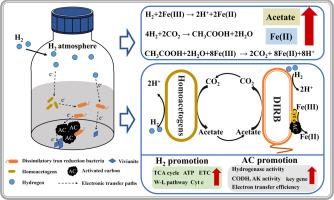当前位置:
X-MOL 学术
›
Water Res.
›
论文详情
Our official English website, www.x-mol.net, welcomes your
feedback! (Note: you will need to create a separate account there.)
Enhance Fe(III) reduction in sludge fermentation for vivianite formation using exogenous H2 assisted by activated carbon
Water Research ( IF 11.4 ) Pub Date : 2024-10-28 , DOI: 10.1016/j.watres.2024.122708 Haoyang Li, Yi Wang, Linyan He, Yifei Wang, Miao Liu, Li Gu, Shaowu Liu, Jinze Li, Yushu Yang, Ruizhi Wang, Qiang He
Water Research ( IF 11.4 ) Pub Date : 2024-10-28 , DOI: 10.1016/j.watres.2024.122708 Haoyang Li, Yi Wang, Linyan He, Yifei Wang, Miao Liu, Li Gu, Shaowu Liu, Jinze Li, Yushu Yang, Ruizhi Wang, Qiang He

|
Vivianite, a notable secondary mineral formed through dissimilatory iron reduction (DIR), demonstrates great potential in addressing both eutrophication and phosphorus deficiency. However, the presence of competition for electrons from the methanogenic pathway and the low rates of Fe(III) reduction limit the creation of vivianite. In this research, H2 was utilized as electron donor assisted by activated carbon (AC) to promote Fe(Ⅲ) reduction with FePO4 as electron acceptors. The introduction of H2 and H2 /AC increased the Fe(III) reduction by 23.8 % and 34.3 %, respectively. Both also increase the rate of vivianite formation. H2 acted as an electron donor to promote Fe(III) reduction by both direct Fe(III) reduction and homoacetogenesis-acetate reduction pathways. It also suppressed the process of methanogenesis to avoid extra consumption of electrons. AC increased the rate of electron transfer, increased hydrogenase and homoacetogenesis-related enzyme activities, and enriched more Dissimilatory iron reduction bacteria (DIRB). H2 promoted the up-regulation of Wood-Ljungdahl pathway, TCA cycle and electron transport chain related genes. AC enhanced H2 capture and functioned as an electron shuttle. These results offer fresh perspectives on promoting Fe(III) reduction to facilitate vivianite formation.
中文翻译:

在活性炭的辅助下,使用外源性 H2 增强污泥发酵中 Fe(III) 的还原,以形成 vivianite
Vivianite 是一种通过异化铁还原 (DIR) 形成的显着次生矿物,在解决富营养化和磷缺乏方面显示出巨大潜力。然而,来自产甲烷途径的电子竞争的存在和 Fe(III) 的低还原速率限制了 vivianite 的产生。在这项研究中,H2 被用作活性炭 (AC) 辅助的电子供体,以 FePO4 作为电子受体促进 Fe(III.) 还原。H2 和 H2/AC 的引入使 Fe(III) 的减少分别增加了 23.8% 和 34.3%。两者都增加了 vivianite 的形成速度。H2 作为电子供体,通过直接 Fe(III) 还原和同源乙酸酯还原途径促进 Fe(III) 还原。它还抑制了甲烷生成过程,以避免额外消耗电子。AC 提高了电子转移速率,增加了氢化酶和同源乙酸生成相关酶活性,并富集了更多的异化性铁还原菌 (DIRB)。H2 促进 Wood-Ljungdahl 通路、TCA 循环和电子传递链相关基因的上调。AC 增强了 H2 捕获并起到电子穿梭的作用。这些结果为促进 Fe(III) 还原以促进 vivianite 的形成提供了新的视角。
更新日期:2024-10-28
中文翻译:

在活性炭的辅助下,使用外源性 H2 增强污泥发酵中 Fe(III) 的还原,以形成 vivianite
Vivianite 是一种通过异化铁还原 (DIR) 形成的显着次生矿物,在解决富营养化和磷缺乏方面显示出巨大潜力。然而,来自产甲烷途径的电子竞争的存在和 Fe(III) 的低还原速率限制了 vivianite 的产生。在这项研究中,H2 被用作活性炭 (AC) 辅助的电子供体,以 FePO4 作为电子受体促进 Fe(III.) 还原。H2 和 H2/AC 的引入使 Fe(III) 的减少分别增加了 23.8% 和 34.3%。两者都增加了 vivianite 的形成速度。H2 作为电子供体,通过直接 Fe(III) 还原和同源乙酸酯还原途径促进 Fe(III) 还原。它还抑制了甲烷生成过程,以避免额外消耗电子。AC 提高了电子转移速率,增加了氢化酶和同源乙酸生成相关酶活性,并富集了更多的异化性铁还原菌 (DIRB)。H2 促进 Wood-Ljungdahl 通路、TCA 循环和电子传递链相关基因的上调。AC 增强了 H2 捕获并起到电子穿梭的作用。这些结果为促进 Fe(III) 还原以促进 vivianite 的形成提供了新的视角。

































 京公网安备 11010802027423号
京公网安备 11010802027423号